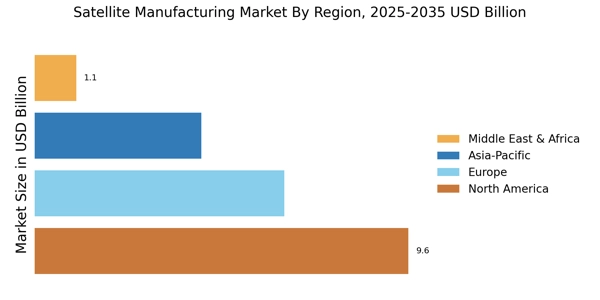Emergence of New Space Economy
The Satellite Manufacturing Market is being transformed by the emergence of a new space economy, characterized by the rise of commercial space ventures and private satellite operators. This shift is leading to increased collaboration between traditional aerospace companies and startups, fostering innovation and reducing costs. The market is projected to see a significant increase in the number of small satellite launches, with estimates suggesting that over 1,000 small satellites could be deployed annually by 2027. This trend is indicative of a broader movement towards democratizing access to space, which is likely to reshape the competitive landscape of the Satellite Manufacturing Market.
Advancements in Satellite Technology
The Satellite Manufacturing Market is experiencing rapid advancements in technology, which are driving innovation and efficiency. Enhanced materials, miniaturization, and improved propulsion systems are enabling manufacturers to create more capable and cost-effective satellites. For instance, the integration of artificial intelligence and machine learning in satellite operations is streamlining data processing and enhancing decision-making capabilities. As a result, the market is projected to grow at a compound annual growth rate of approximately 8% over the next five years, reflecting the increasing demand for sophisticated satellite systems. This technological evolution not only improves performance but also reduces operational costs, making it a pivotal driver in the Satellite Manufacturing Market.
Regulatory Support and Policy Frameworks
The Satellite Manufacturing Market is experiencing favorable regulatory support and policy frameworks that encourage growth and innovation. Governments are recognizing the strategic importance of satellite technology for national security, communication, and environmental monitoring. Recent policy initiatives aim to streamline the licensing process for satellite launches and operations, thereby reducing barriers to entry for new market participants. This supportive environment is expected to stimulate investment and foster a more competitive landscape within the industry. As regulations evolve to accommodate advancements in technology and the increasing number of satellite operators, the Satellite Manufacturing Market is likely to thrive in the coming years.
Increased Investment in Space Exploration
The Satellite Manufacturing Market is benefiting from increased investment in space exploration initiatives by both governmental and private entities. Countries are allocating substantial budgets to develop satellite systems that support scientific research, Earth observation, and planetary exploration. For example, recent government reports indicate that space agencies are expected to invest over $20 billion in satellite manufacturing and related technologies in the coming years. This influx of capital is fostering innovation and competition within the industry, as new players enter the market and established companies expand their capabilities. The emphasis on exploration and research is likely to propel the Satellite Manufacturing Market to new heights.
Growing Demand for Communication Satellites
The Satellite Manufacturing Market is witnessing a surge in demand for communication satellites, driven by the increasing need for high-speed internet and connectivity solutions. With the proliferation of smart devices and the Internet of Things, the requirement for robust communication infrastructure has never been more critical. According to recent estimates, the communication satellite segment is expected to account for over 50% of the total satellite manufacturing revenue by 2026. This trend is further fueled by the expansion of 5G networks, which necessitate advanced satellite systems to support enhanced data transmission capabilities. Consequently, manufacturers are focusing on developing next-generation communication satellites to meet this growing demand.


















Leave a Comment